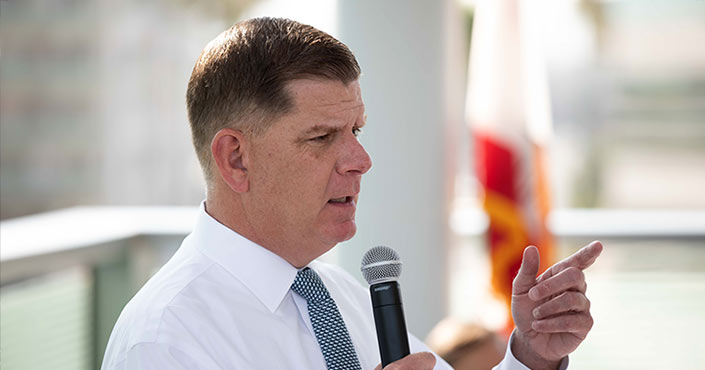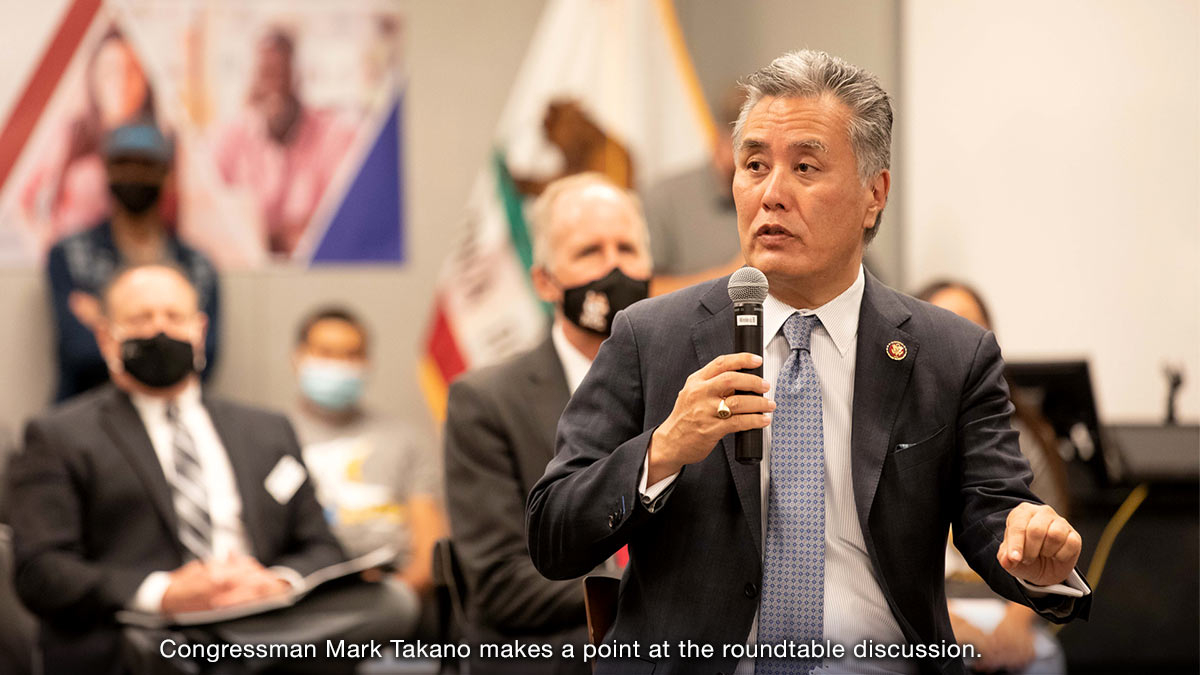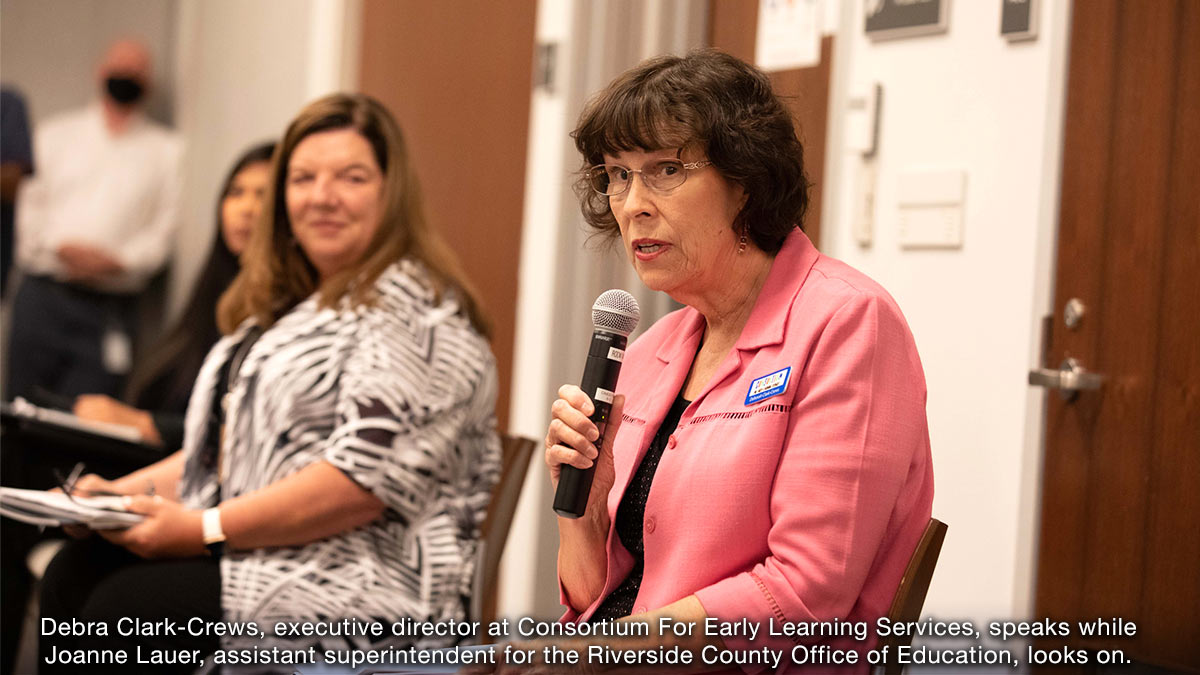US Secretary of Labor Visits RCCD
07/08/2021

Secretary of Labor Martin J. Walsh spoke to education leaders at a round-table meeting this morning held in downtown Riverside about the Child Tax Credit and its effect on early childhood education. The meeting took place at the headquarters of the Riverside Community College District (RCCD) after a breakfast catered by the RCC Culinary Academy with Secretary Walsh, Congressmember Mark Takano and representatives of labor organizations in the Inland Empire. The secretary and congressmember are meeting with several groups about White House plans and infrastructure during a swing through Southern California.
Walsh, who joined the administration less than four months ago, has a history of driving discussions on creating well-paying jobs, protecting workers' rights, the expansion of mental health treatments, and investing in public transit. He comes from a family of laborers. His father was a member of the Laborers Local 223 in Boston, and Walsh himself led the Building and Construction Trades Council from 2011 to 2013. As mayor of Boston, he worked with business and community leaders to promote high-quality development, and he created a program called Building Pathways that has become a model for increasing diversity in the workplace and providing good career opportunities for women and people of color.


While addressing labor representatives at the breakfast, Walsh encouraged support for RCCD community colleges, and then met with several RCC Culinary Academy students, the Launch pre-apprenticeship students and a IBEW second-year apprentice before attending the roundtable meeting on childcare where he stressed the need for additional funding for early childhood services and increased compensation for childhood educators.
Per a White House bulletin, preschool is critical to ensuring that children start kindergarten with the skills and supports that set them up for success in school. The White House says that research shows that children who attend universal pre-K are more likely to take honors classes and less likely to repeat a grade, and another study finds low-income children who attend universal programs do better in math and reading as late as eighth grade.
“Investment in early childhood education … is investment in America's future," Walsh said. “Quite honestly we are all out across the country talking about it, and Republicans and Democrats alike are saying wait a second this is great we are going to make investments in early childhood education, and we are going to respect the workers who work in that field and strengthen that field and make a long-term investment."
President's Joe Biden's American Families Plan calls for an additional $200 billion to provide free universal pre-school for 3- and 4-year-olds. The American Rescue Plan approved by Congress raised the maximum Child Tax Credit in 2021 to $3,600 for children under the age of 6 and to $3,000 per child for children between the ages of 6 and 17 years of age. Previously, the child tax credit provided $2,000 per eligible child.
The new maximum credit is available to taxpayers with a modified adjusted gross income of $75,000 or less for singles, $112,500 or less for heads of household and $150,000 or less for married couples filing a joint return and qualified widows and widowers.
According to Congressman Takano, a former member of the RCCD Board of Trustees, families should start seeing funds arrive July 15. Takano said 190,000 families in his district (41) will receive funds beginning next week.

“We also want to highlight that while the childcare tax credit is going to be a huge
help to these families as we climb out of this pandemic; we still have a need to build
a care economy which means we need to support the work these care workers, whether
child or elderly, do (daily)," he said. “Childcare is one of the things that is holding
back our recovery. Childcare is something we need to pay attention to. The care economy
is a significant part of the infrastructure that we need to get through (Congress)."
A White House fact sheet stated that by providing additional funding for preschool children the US “will see an increase in labor force participation among parents - especially women — boosting family earnings and driving economic growth. By some estimates, the benefits of a universal pre-K system to US GDP are more than three times greater than the investment needed to provide this service."

James J. Heckman, a Noble Laureate in economics, was cited for his research in identifying that for every dollar spent on effective childcare services, there is a return of $7 to the nation's economy. Studies have also shown that individuals who aren't exposed to early childhood education services are 25 percent more likely to drop out of school; 40 percent more likely to become a teen parent; and 70 percent more likely to be arrested for a violent crime. The cost to house one prisoner exceeds the cost to educate six children in a Head Start program.
Studies on attending an early childhood education center include an increase in graduation rates; a higher rate in persistence; higher grades in college; fewer years to degree completion; and college-going parents are more likely to remain in classes.
Yet, as noted by the White House, there is a “difficulty in finding high-quality, affordable childcare.
RCC's Child Development Center is open to the public and can accommodate children from six weeks old to 5 years of age, it is limited, however, to 105 enrollees. The Center budgets 75 percent of enrollment for the public and 25 percent for student's children. Meanwhile, Moreno Valley College's Early Childhood Center is licensed for 72 children from the age of 2 to 5 years of age. Norco College is developing the Stokoe Innovation Learning Center with Alvord Unified District thanks to a $5 million state grant. When opened it will become a model in teaching and early care innovation.
The White House report noted that the inability to find affordable childcare “leads some parents to drop out of the labor force entirely, some to reduce their work hours, and others to turn down a promotion." Doing so can add to lifetime consequences when it comes to lifetime earning potential, savings, and even retirement.
Shari Yates, interim dean of CTE at RCC and an instructor for early childhood education, addressed how low wages impact the childcare workforce, which is primarily women. Currently, preschool teachers in California earn an average hourly wage of $16.64, however, introductory salaries can begin as low as $11.96. To earn a living wage in Riverside County, research suggests that an employee would need to earn at least $21.76 per hour.

“We know how important (early childhood care is) and yet we need to address the low wages caregivers receive," she said.
Under the American Rescue Plan, childcare providers would receive funding to cover the true cost of quality early childhood care and education-including a developmentally appropriate curriculum, small class sizes, and culturally and linguistically responsive environments that are inclusive of children with disabilities. At the same time, childcare providers would see an increase in wages.
The American Rescue Plan also provides full coverage of childcare expenses for a child whose family earns 1½ times the state median income, and no family would pay more than 7 percent of their income for childcare for children under age 5. The plan will also provide families with a range of inclusive and accessible options to choose from for their children, from childcare centers to family childcare providers to Early Head Start.
“Over the course of the next few days I am going to be visiting job sites to talk to individuals about what is exactly in these plans and how we are going to strengthen the middle class," Walsh said. “The pandemic has hit the childcare industry in a very difficult way and a lot of childcare centers aren't open. But even before that, the proper investment wasn't made in the childhood industry."
Debra Clark-Crews, executive director at Consortium For Early Learning Services, presented a pre-pandemic report on the childcare services needs in just Riverside County, and it was sobering.

According to Clark-Crews there are 190,000 children from the age of 0 to 5 in the county. Of the 190,000 children, 78,000 are eligible for income assistance. Yet, there is room for just 17,000 (22 percent) in existing early childcare organizations. Within California's 41st Congressional District there are 71,000 eligible children; yet just 7,000 have a space, less than 50 percent.
And that is before the pandemic shuttered childcare centers or forced a reduction in available slots.
Joanne Lauer, assistant superintendent for the Riverside County Office of Education, provided post-COVID numbers that reflected the dire need for quality childcare services in the county. Lauer said, RCOE is currently serving over 12,000 students through its care program. Unfortunately, there are 10,777 children on the waitlist.
“We have a challenge in this county, (and) this district, as well as in this state," said Clark-Crews, who has been in the field for over 30 years. “The lack of childcare, and the support for childcare (as a whole) has been a longtime in coming."
Published by External Relations & Strategic Communications

